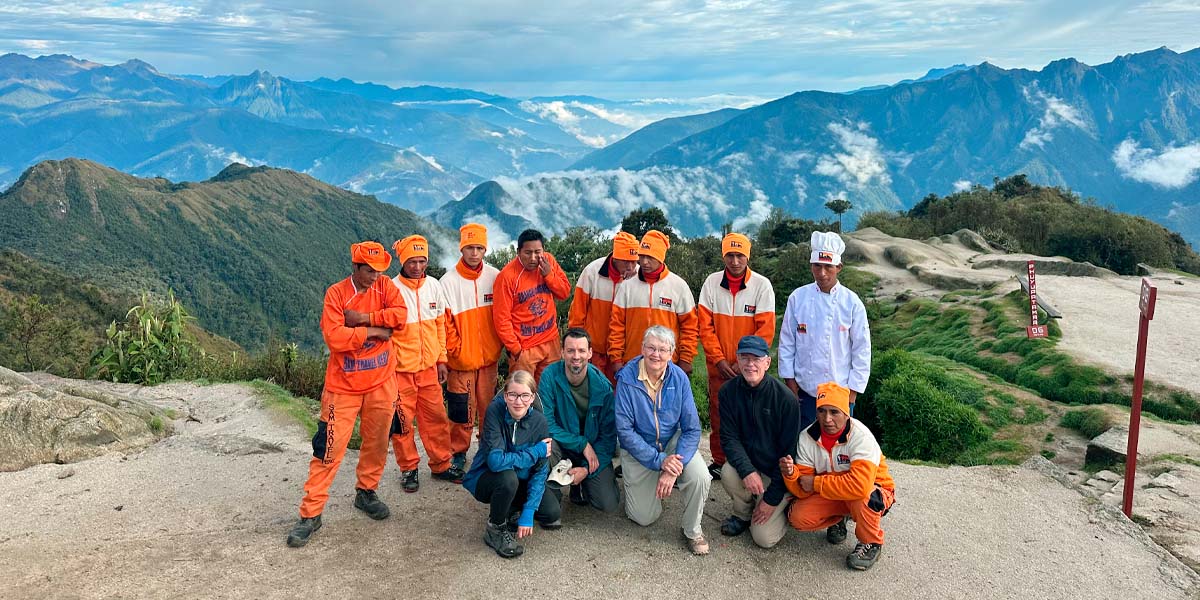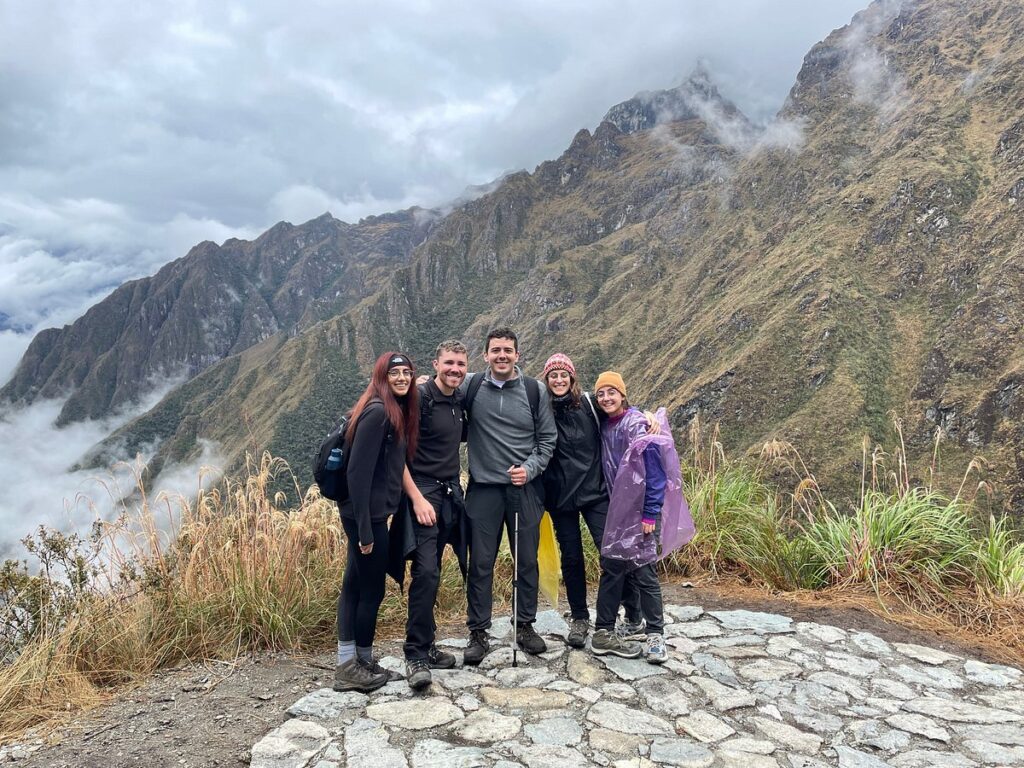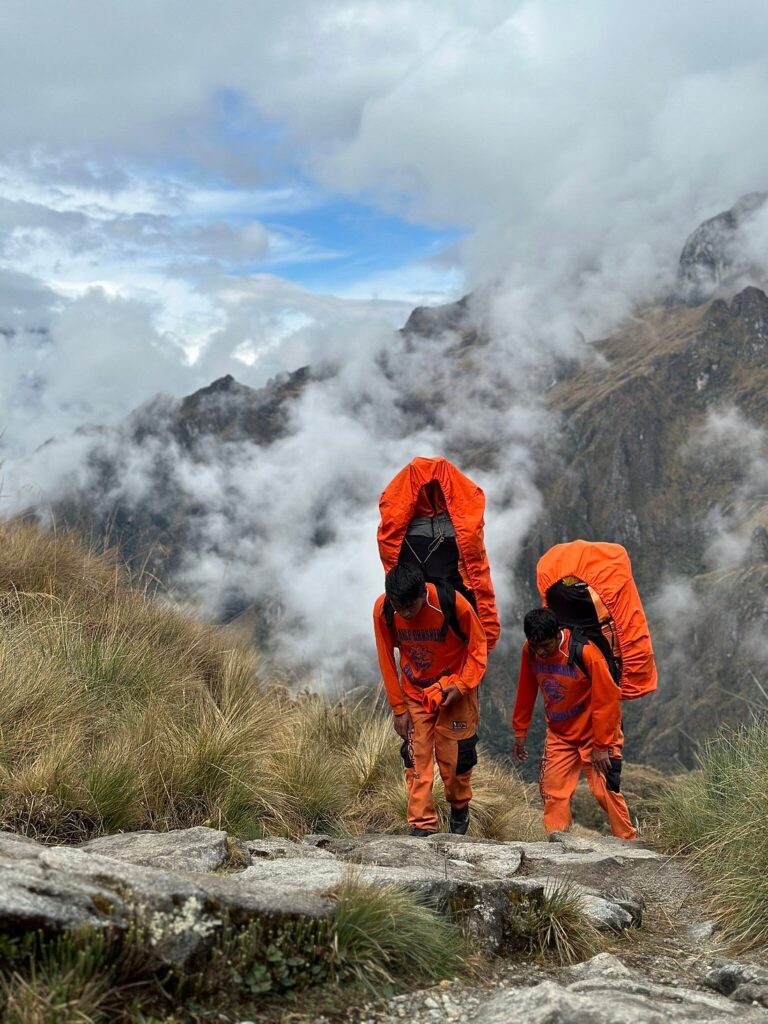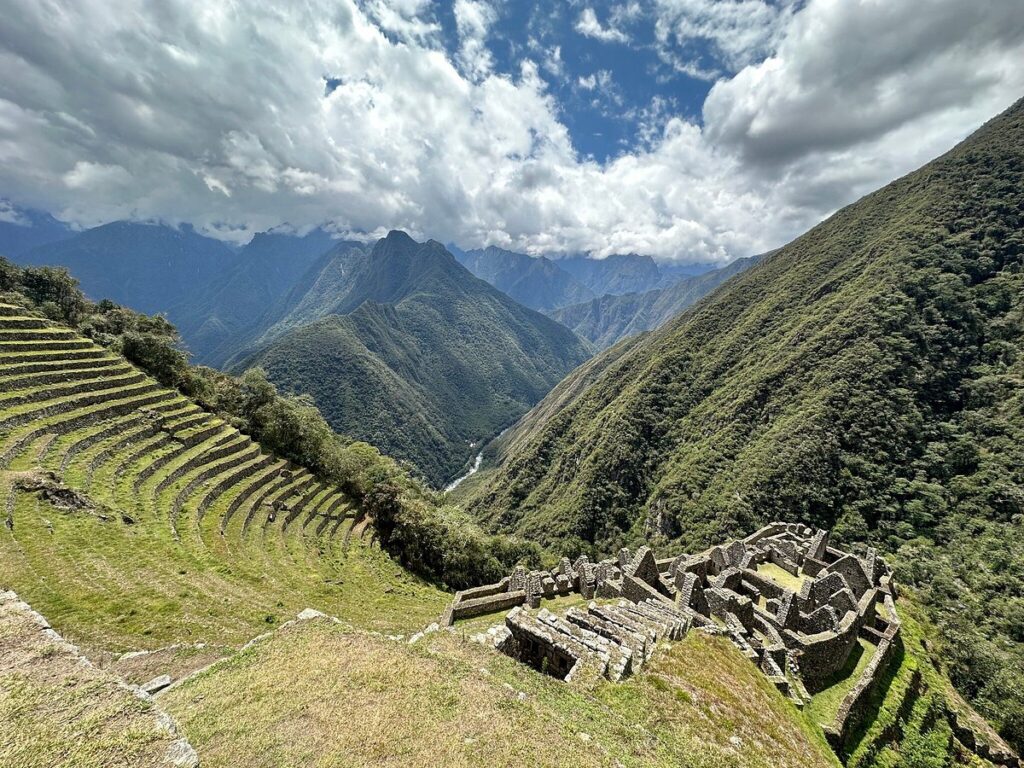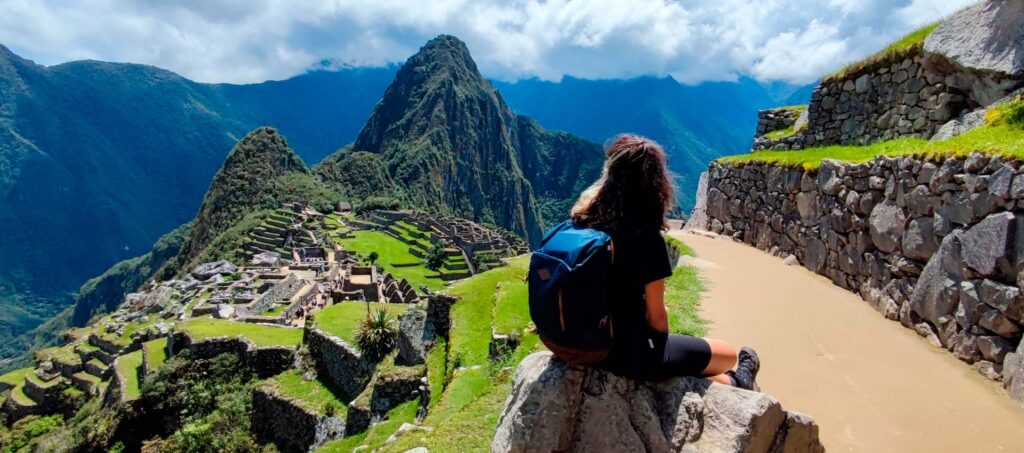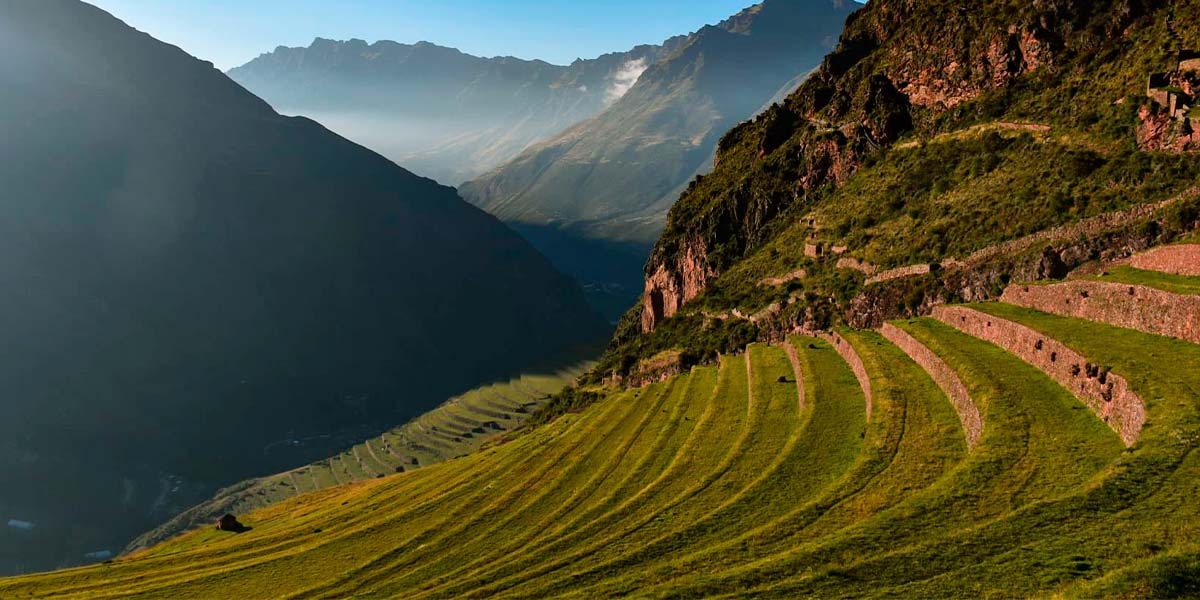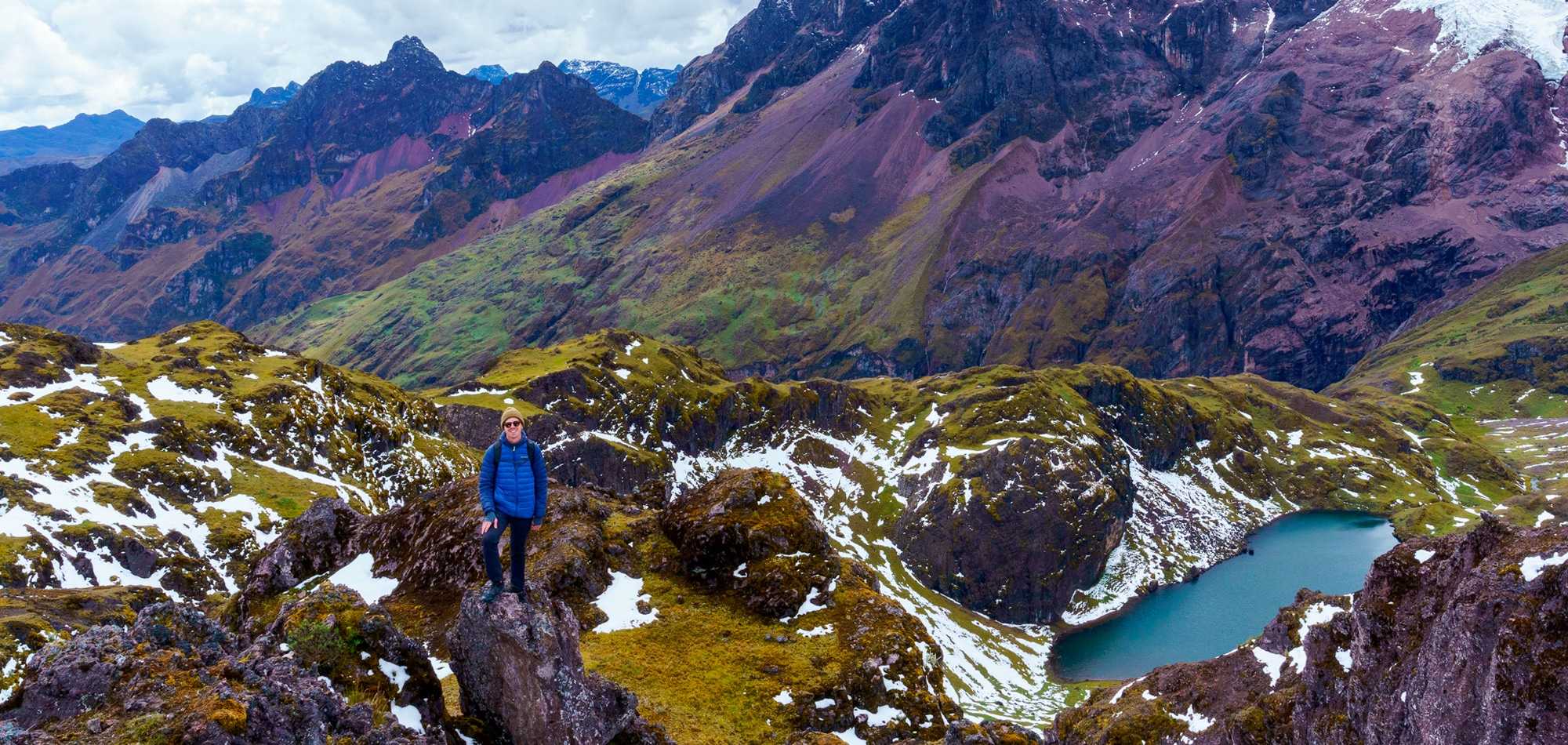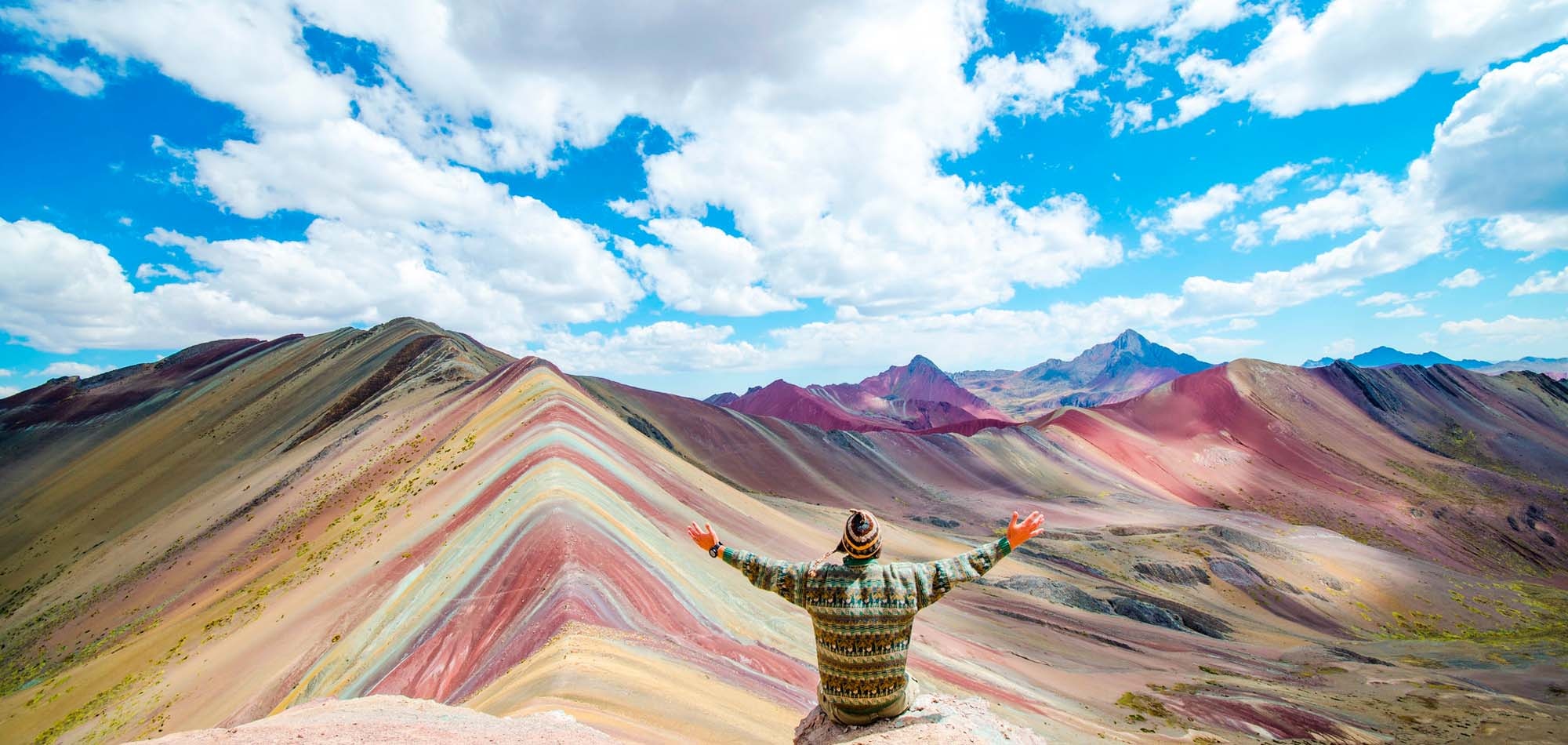Classic Inca Trail to Machu Picchu 4 days

4 days - 3 night

Up to 8 people

Moderate – challenging

4215 m.s.n.m

Trek, adventure
The Classic Inca Trail is an illustrious trek featured in many travel blogs, magazines and TV shows and it is truly deserving of its popularity. Start your trail in the quaint town of Ollantaytambo, pass stunning landscapes whilst experiencing a diverse range of microclimates, before culminating your journey in the UNESCO World Heritage Site of Machu Picchu, the most sought-after New 7 Wonders of the World. Trek through alpine forests, rugged mountain valleys before arriving in the cloud forest which offers pristine waterfalls and prolific jungle vegetation. Immerse yourself in ancient Inca culture in the plethora of Inca ruins that give you a glimpse into the life of one the most advanced ancient civilizations.
4 days/3 nights, 26 miles (42km) of hiking on varied mountainous terrain through the Andean highlands, followed by the incredibly biodiverse cloud forest and finally ending at the foot of the tropical-climate Amazon Rainforest. This is where the magnificent Machu Picchu citadel sits, surrounded by some of the most unique and biodiverse species on Earth.
The Classic Inca Trail is not to be a missed, a bucket list item for adventure seekers, history buffs, nature enthusiasts, foodies, spiritual seekers, photographers, families and solo travelers. Make sure to book in advance, tickets sell-out incredibly fast, especially during peak season.
Day 1: Cusco – Piskacucho Km 82 – Wayllabamba
An early 4am pick-up from Cusco will take us through the Sacred Valley to the trailhead in Piskacucho KM 82 ( 2,700 m/ 8,856 ft). We will make a quick stop for breakfast along the way (not included in the price). Once we pass the main checkpoint we hike along the Vilcanota River for about three-hour to our lunch spot in Tarayoc. We then continue uphill to the Inca fortress Huillca Raccay which has breathtaking views of the archeological site of Llactapata and the snowcapped mountain peak of W´akay Willca
Another 2 hours on a steep incline to reach our campsite in Ayapata. Here, our porters will have camp already set-up and a lovely spread of afternoon tea accompanied by snacks. After a scrumptious dinner we settle in for our first night in the mountains.
- Meals: Lunch and Dinner
- Accommodation: Camping
- Difficulty: Easy/Moderate
Day 2: Wayllabamba – Pacaymayu
Our day starts at 5am with a cup of hot coca tea, a bowl of warm water and a hearty breakfast. The first section for the day is a steep incline through the cloud forest to Llulluchapampa (3 800m/12 460ft), gaining almost 800m/2 625ft in elevation. After a short break we continue our climb to the highest pass of the trek, Dead Women´s Pass (4 200m/13 779ft).
Next is a welcomed descent to our lunch spot in Pacaymayu (3 580m/11 700ft). Later we embark on our second ascent for the day to the Runkuraqay Pass (4 000m/13 123ft). Finally, we descend to the archeological site of Sayacmarka (3 650m/11 975). After some time exploring this Inca site we make our way down to camp in Chaquicocha (3 600m/11 800ft). As the norm, at camp we enjoy some afternoon tea followed by a scrumptious dinner.
- Meals: Breakfast, lunch, afternoon tea and dinner
- Accommodation: Camping
- Difficulty: Challenging
Day 3: Pacaymayu – Wiñay Wayna
Day 3 is has the most impressive scenery and a slew of Inca Ruins to explore. Added to that is a warmer climate, brought on by the approaching Amazon Jungle. Start the day at a more reasonable hour of 6am, with a hot cup of tea and a nutritious breakfast. First, is a gentle climb to the archeological site of Phuyupatamarca «village in the clouds» (3 680m/12 073ft). Enjoy the panoramic views of canyons, waterfalls and snow-broached mountain tops.
A descent on about 3000 Inca steps takes us to our next archeological site of Intipata. Next is the third and final archeological site of the day, the Forever youthful site of Wiñay Wayna. Camp is only a short walk away and lunch, afternoon tea and dinner will all be served at this camp. Wiñay Wayna (2,650 m/8,692 ft) is warm and humid and has great views of the lush valley and the Urubamba River below.
- Meals: Breakfast, lunch, afternoon tea and dinner
- Accommodation: Camping
- Difficulty: Moderate
Day 4: Wiñay Wayna – Machu Picchu – Cusco
On the last day you wake up the earliest because of a number of factors. Firstly, those invaluable porters that carry and prepare everything for us on the trek, well today they need to rush and catch the only staff train available to them which departs at 5:00am. Secondly, Machu Picchu open at 5:30am and we want to be in line to be one of the first groups to enter, so we can watch the sun rise over the citadel like melting gold.
The moment we´ve been waiting for is finally here. As we walk through the Sun Gate (Inti Punku), the sheer size, scale, and sophistication of the Inca city will leave you spell bound. Continue downhill on the royal path to the awe-inspiring and surreal Machu Picchu Citadel (2,400m/7,872 ft). After walking for about 40 minutes, we enter the Citadel of Machu Picchu from the top through the “House of the Guardians” where you can take the famous postcard pictures of Machu Picchu.
- Meals: Breakfast, lunch (not included in the price)
- Difficulty: Easy
Additional information
Included is an informative guided tour of Machu Picchu. After your guided tour of Machu Picchu, those who have booked for the extra hike up Huayna Picchu in advance will have time to enjoy those views on their own. When you have had your fill of the exceptional views of Machu Picchu, you will take the bus back down to Aguas Calientes for lunch (not included). Depending on your train departure time, you may also have time for some shopping, sightseeing or a visit to the museum or hot springs.
The Expedition Train at 2:55 or 3:20pm will take you back to Ollantaytambo, following the spectacular Urubamba River. Back at Ollantaytambo, your driver will meet you at the exit from the train station to take you back to your hotel in Cusco in our private vehicle. You can expect to arrive at your hotel by 7:00pm.
*** The Huayna Picchu Mountain Hike depends on availability and let us know about it at booking.
WHAT IS INCLUDED?
- Briefing a night before the trek at our office
- Transfer from the airport to your hotel
- Pick up at your hotel
- Private transport from Cusco to Piscacucho (trailhead)
- 5 kgs of your personal items extra clothes, sleeping bag to be carried by the porters, just carry your daypack
- 4 person Igloo tents (large and comfortable) for each 2 trekkers
- Foam mattresses and camping pillows
- English speaking professional guide experienced in mountains and archeology
- Meals as indicated in the itinerary (special dietary needs accommodated with prior request)
- First-aid kit including emergency oxygen tank
- Porter to carry tents, food, cooking equipment
- Warm water to freshen up
- Boiled water to fill in your bottles after each meal
- Dining and cooking tents with tables and chairs
- Chef, cooking equipment
- Expedition Tourist Train from Aguas Calientes to Ollantaytambo and private transport to Cusco
- Permit for the Inca Trail
- Entrance to Machu Picchu Inca Citadel
- Guided tour of Machu Picchu
- 3 bus tickets from Machu Picchu – Aguas Calientes – Machu Picchu
- Expedition train from Aguas Calientes to Ollantaytambo
- Transfer back to Cusco hotel
- Admission permits for the Inca Trail
- Entrance ticket to Machupicchu
- 2 hour guided tour
- Chef and cooking equipment
- Dining tents with tables and chairs
- Day pack rain covers
WHAT IS NOT INCLUDED?
- Huayna Picchu: $75 USD Please let us know at booking.
- Machu Picchu: $75 USD Please let us know at booking.
- Hotel before and after the trek
- Travel Insurance (highly recommended)
- Flight tickets
- First breakfast and Last lunch – We will stop at Ollantaytambo for the first breakfast and have the last lunch at Aguas Calientes after the tour of Machu Picchu.
- Upgrades: Vistadome train US $57 per person (return trip only)
- *** Tips for the crew, guide, cook and porters ORANGE NATION PERU
- – Our staff receives a fair wage immediately after their trip has ended, tips are optional but they do greatly appreciated them.
Price
GROUP SERVICE PRICE
- $750 USD per person
PRIVATE SERVICE PRICE
- Price for 6-8 trekkers: 900 USD per person
- Price for 3-5 trekkers: 950 USD per person
- Price for 2 trekkers: 1100 USD per person
Service Upgrades
- If you’d like more flexibility in your return travel to Cusco, consider upgrading to the Vistadome train (Executive Class). This upgrade must be requested at the time of booking.
- Any upgrades or trip extensions must be requested at booking.
Optional Activities
- Extra Day at Machu Picchu Pueblo (Aguas Calientes)
- Activities in town include: Machu Picchu butterfly garden, Mador (waterfall), Hotsprings, Putucusi Mountain (2 hour steep hike) or Plaza Manco Capac (picturesque square adorned with Inca statues)
- If you’d like to hike Huayna Picchu or Machu Picchu Mountain, let us know at booking as it requires a separate permit.
- Huayna Picchu is an optional trek within Machu Picchu Citadel which doesn´t include a guide. The climb is usually done on your own after your tour of Machu Picchu Citadel. If you would like the extra hike to be guided, please request in advance. There is an extra cost for this extra guided tour.
| Why Private? | Why small group service? |
| Exclusivity: Private tours offer a more exclusive experience, since you will be accompanied by a guide exclusively dedicated to your group. Flexibility: You will have more flexibility regarding the start dates and duration of the trek. You can customize the itinerary according to your interests and needs. Personalized Pace: You can walk at your own pace and stop whenever you want to enjoy the views or rest. Personalized Services: Private tours often offer more personalized services, such as private chefs, exclusive porters, and high-quality meals. | Shared Cost: Small group tours are usually cheaper than private tours, as costs are shared between participants. Social Experience: It is a great way to meet other people with similar interests. You can share the experience with other travelers. Fixed Departure Date: Small group tours have scheduled departure dates, so you must adapt to those available dates. Specialized Guides: Although you will not have an exclusive guide, small group guides are experts on the route and will provide valuable information. |
HOW TO BOOK THE CLASSIC INCA TRAIL TO MACHU PICCHU TREK?
FIRST, to book your Classic Inca Trail to Machu Picchu trek, we need you to fill out our booking form by clicking on BOOK NOW on our home page or click here – BOOK NOW.
Please be ready with the following information (FROM EACH PARTICIPANT in your group). We cannot purchase a 4-Day Inca Trail Hike to Machu Picchu permit without the following information:
- Personal information (your full name, exactly as it appears on your passport):
- Gender
- Passport number
- D.O.B. (dd / mm / yyyy)
- Nationality
SECOND, we require a deposit of $211.00 USD per person in order to purchase a permit for the Classic Inca Trail to Machu Picchu. You can make your deposit by clicking on the PAYPAL symbol on the top of our home page, or you can click on the PAYPAL symbol on our booking page.
Packing List for the Classic Inca Trail 4 days tour
WHAT YOU HAVE TO TAKE WITH YOU
- Original passport (has to be the same as the one used to book your trek)
- Valid University card (if you booked as a student)
- Good daypack (the smaller, the better)
- Water storage: 2-3 L (Camelbaks are encouraged)
- Comfortable hiking boots with ankle support
- Sleeping bag (can be rented from Orange Nation)
- Headlamp: essential
- Toilet paper
- Good rain gear.
WHAT TO PUT IN THE DUFFEL BAG
As a Direct Local Tour operator, we provide you with a duffel bag at your briefing and INCLUDE an extra porter, who will carry up to 7kgs/15lbs including your sleeping bag, mattress and extra clothing. By Peruvian law, a duffel bag must not weigh more than 7 kilograms (15lbs). This limit is set to protect the health of the porters or horses. All bags will be weighed before being accepted. If you require more than 7 kilograms, it will then be your responsibility to carry the extra weight with your day pack. In this 7 kilos, please count 2 kilos for your sleeping bag and 1 kilo for your sleeping pad. This leaves you about 4 kilos for your personal gear. If you need to hire an extra private porter, please request at book, this can be done for a fee.
- 2 t-shirts
- 2 hiking pants at least
- 4 sets of undergarments
- 3 sets of hiking socks
- Fleece/ Thermals
- Warm clothes, down jacket — 2nd campsite temp around 3º C
- Waterproof gloves (even if they are ski gloves)
- Comfortable shoes for camp
- Quickdry towel. We provide small ones, you might prefer something larger
- Small bottle of soap: we provide warm water in a basin each day to wash
- Battery Charger: No electricity along the trek
- Large plastic bags will be provided at the office to line your duffel
- Sleeping bag: It has to be at least -15ºC – This can be rented from us for $20 USD
TOILETRIES
- Face moisturizer
- Hand sanitizer
- Wet wipes
- Toothbrush and toothpaste
- Personal medications
- First aid kit: band aids, moleskin, etc.
WHAT TO PUT IN THE DAY BACKPACK
We highly recommend a small backpack 30 to 40L for hiking in the day. A big backpack will not be allowed into Machu Picchu. The remainder of your belongings will be in your duffel bag at camp.
- Water: Please supply your own water until the first lunch spot, then we will provide you with cold boiled water at every meal time. Please bring your canteens.
- Sun hat and sunglasses
- Sunscreen
- Insect repellent
- Headlamp
- Wool hat and gloves
- Rain gear
- Fleece or warm layer
- Snacks like chocolate bars, cereal bars or any dry fruits
- Personal First Aid kit and personal medications
- Camera
- Hand sanitizer
- Toilet paper and small plastic bag for waste
- Valuables
***IMPORTANT:
- On the 4 day Inca Trail, we will be doing the Circuit #3 or #4 and there is no way to do another circuit unless you buy an additional entrance to Machu Picchu (US$57).
- You can upgrade to the Vistadome Train for the same times, 2:55 or 3:20, 4:22, or 4:43pm. The cost is $67 USD.
- Early trains can be organized on request, but it has to be done at booking.
FAQs Classic Inca Trail to Machu Picchu
The Classic Inca Trail begins at «Kilometer 82» or «Piscacucho» and ends at the majestic citadel of Machu Picchu in Peru. Along the approximately 42 kilometers of this trail, hikers traverse diverse Andean landscapes, pass several Inca archaeological sites and finally reach their destination at Machu Picchu.
The Inca Trail is a historic trekking route through the Andes Mountains in Peru that leads to the ancient ruins of Machu Picchu, one of the world’s most famous archaeological sites. The trail was originally built by the Incas over 500 years ago and includes a series of well-preserved stone pathways, staircases, tunnels, and terraces.
Yes, absolutely. Concerns about the overuse of the trail lead the Peruvian government to enact a few regulations. First and foremost everyone needs a permit to enter the Inca trail. Second, these permits can only be purchased by licensed tour operators. Next, you cannot do the Inca Trail without a licensed tour operator and guide. Additionally, there are only 500 permits available per day, out of the 500, 300 are used by support staff such as guides, porters and cooks, which essentially means only 200 permits are available for tourists and trekkers.
High season (May to September):
- This is the most popular time to do the Inca Trail due to the dry and pleasant weather.
- The months of June, July and August are the busiest and permits usually sell out quickly.
- During these months, the days are sunny and the nights are cold, so it is recommended to bring warm clothing.
- The views are clear and spectacular.
Shoulder Months ( April, October, November):
Savvy travelers prefer to enjoy the best of both worlds with an Inca Trail hike during the shoulder months. The weather can be unsettled (on Saturday you could be basking in the sunshine while on Monday there could be heavy showers), but there are usually lots of great walking days to be had. The trails are relatively quiet, yet you won’t have the deluges of the wet season to contend with. Come after the rains in April and enjoy lush green landscapes for enviable photos!
Low season (December to March):
- This is the rainy season in the region. January and February are the rainiest months.
- For this reason the Inca Trail is closed for maintenance in February.
- You can still do the Inca Trail during these months, however you just need to be aware that it is very likely to rain and the trail gets slippery. Hiking Huayna Picchu Mountain at this time is also extra difficult and your view may be shrouded by fog.
- The trail has less people, and the landscape is lush due to the rains.
The Inca Trail is considered a moderate to strenuous hike with steep inclines, declines, high altitude, and rough terrain.
The most challenging things about the Inca Trail:
- The Altitude: From the trailhead you gain about 1480m/4856ft in elevation in just two days. The highest point of the trail is known as Dead Woman’s Pass at an elevation of 13,780 feet (4,200 meters).
- The steps: There are about 70 866 steps on the Inca Trail (that´s if you believe google). Importantly, the trail is undulating with ten´s of thousands of Inca steps to negotiate. This puts added weight and pressure on the knees, especially on the downgrades.
- Time spent walking: You hike an average of 6 hours everyday depending on your pace and this can be exhausting.
How to overcome these challenges.
- Acclimate properly: Spend 2 days or more in Cusco or the Sacred Valley so your body can adjust to the new altitude.
- Stay hydrated: You might not feel thirsty at high altitude, but trust us, you hydrate a lot faster and drinking plenty of liquids and staying away from alcoholic drinks helps curb the affects of altitude sickness.
- Try the local remedy: Coca leaves have been used for many generations to combat altitude sickness and to give an extra boost of energy. Whilst on the trail, coca tea is served first thing every morning and you can also chew the leaves throughout the day.
- Prepare your body: The Inca Trail is no joke: Hiking it over four days requires you to be in peak physical condition. Use things like the stair climber to strengthen your knees or go on a few hiking trails near you prior to starting the trek. Also build your endurance and stamina through regular exercise a few months in advance.
The Inca Trail is a spectacular hike that takes you through stunning landscapes and important archaeological sites along the trail.
- Kilometer 82: This is the official starting point of the Inca Trail, located 82 kilometers northwest of Cusco. Here the walk to Machu Picchu begins.
- Llaqtapata: Llaqtapata is an Inca archaeological site that offers panoramic views of Machu Picchu. It is a quiet and scenic place to rest and enjoy the views. You can only visit this site on the 5-Day Inca Trail
- Runkuraqay: This is a stop along the way that used to be a tambo or resting post for Inca travelers. It offers stunning views and is an interesting place to explore.
- Sayacmarca: Sayacmarca is a well-preserved archaeological site with stone structures and terraces. It offers spectacular views of the surroundings.
- Conchamarca: Another archaeological site on the road that used to be a dairy farm. Here, travelers can learn more about the history of the Inca Trail.
- Phuyupatamarca: This archaeological site is known for its impressive location high in the mountains and its agricultural terraces.
- Wiñay Wayna: Wiñay Wayna is one of the most impressive sites on the Inca Trail. Its agricultural terraces, water fountains and Inca architecture make it an unforgettable stop.
- Inti Punku (Sun Gate): Inti Punku is the gateway to Machu Picchu. From here, visitors can get their first and most panoramic view of the iconic citadel.
- Machu Picchu: The final destination of the Inca Trail is the majestic citadel of Machu Picchu. This archaeological site is one of the most famous in the world and is known for its Inca architecture, terraces, temples and impressive landscapes.
Here are some key aspects of the garbage and waste policy on the Inca Trail:
Take everything you bring: One of the fundamental principles on the Inca Trail is «Leave No Trace.» This means that you must take all the waste you generate during the trek with you. Do not leave trash on the trail, as this can damage the natural environment and archaeological sites.
Organic trash: Organic trash, such as food scraps and peelings, should also be bagged and taken with you. You can carry sealed bags to store this waste and avoid attracting animals. Another option is to bring your organic waste to camp and make sure its disposed of in the correct trash can.
Solid waste: Containers, bottles and other solid waste must be properly packaged. Bring them back to camp and make sure it is properly disposed of in the correct container.
Recycling: We highly recommend bringing reusable water bottles. Avoid plastic bottles and plastic containers. Most importantly, plastic bottles are not allowed inside Machu Picchu.
Responsible use of water: Avoid wasting water during trekking. Use only the amount needed for cooking and drinking. Do not contaminate streams or water sources with soap or detergents.
Portable Toilets: In some areas of the Inca Trail, portable toilets are used. Make sure you follow the instructions and rules for their use and do not throw trash in them.
Information and education: Guides and porters are trained in minimal impact practices and must ensure that hikers follow conservation rules.
***If you see anything that shouldn´t be on the trail, alert your guide. If our team does anything that doesn´t follow the proper disposal of waste, please let the office know. Environmental sustainability and the preservation of our trails is very important to us.
Things to consider before booking your Classic Inca Trail
Age: There is no strict age restriction to do the Inca Trail, but it is important to keep in mind that it is a long and demanding hike. Hikers must be physically fit and able to walk long distances over varied terrain. People over 60 may need a medical evaluation and must be sure they are in good physical condition to trek.
Physical health: It is important that hikers are in good physical health to undertake the Inca Trail. This involves having good cardiovascular endurance, physical strength, and the ability to walk on uneven terrain. If you have any pre-existing medical conditions, such as heart problems, asthma or other health problems, you should consult a doctor before considering trekking. People with knee or ankle problems should also use caution, as the terrain can be steep and challenging.
Altitude: Trekking the Inca Trail involves high altitudes, and altitude may affect some people differently. It is important to acclimatize properly before beginning the hike. This usually involves spending at least a couple of days in Cusco or a similar altitude location before heading out trekking. If you have medical problems related to altitude, you should consult a doctor before deciding to do the Inca Trail.
Medical Insurance: It is highly recommended that hikers have travel insurance that covers medical situations, including evacuation in case of emergency. This is important in case of injuries or medical problems during the hike.
History:
The Inca Civilization has one of the most fascinating history in the world and the Inca Trail takes us on this journey of rediscovery. As we visit a slew of archeological sites along the route, we learn from the descents of this great civilization some of their ancient ways. Explore a live showcase of their engineering and architectural genius. Their sophisticated agricultural terraces which were built on the mountain side are true engineering marvels, with some still fully functional even today. Their decision to also build directly on an earthquake fault line using the ashlar technique is very intriguing. Their stone placement is flawless, you can´t fit a sheet of paper between each stone. Even if you are not the biggest history buff, this particular history is interesting and a bit incredulous.
Scenery:
The trek starts in the Sacred Valley which is characterized by its rolling heels, terraces and traditional Andean Villages. This was the heart of the Inca Empire. It has fertile soils and is nestled among snow-capped peaks.
Next, as you climb higher you enter the cloud forest, one of the most important micro-climates in the world. Its often surrounded by a shroud of soft clouds constantly moving in and out. A magical place that gives a sense of peace, calm and unrivaled beauty. Among the rolling hills are cascading waterfalls and an abundance of unique flora and fauna.
Just above that is the grasslands. At this high altitude, the landscape is treeless with shrubs and other alpine vegetation. From this vintage point you have a panoramic view of the gigantic mountain tops and the snuggly llamas and alpacas grazing in the fields. The view is breath taking, as if you are standing on top of the world.
To end the trail, you enter the foot of the Amazon Rainforest with its hot and humid weather. Home to an astonishing variety of plant and animal species. Machu Picchu sanctuary is a botanical wonderland.
Flora and Fauna:
Flora: Its 3 distinct ecological zones all have their own unique plant species. The cloud forest has ferns, bromeliads, and a vast array of orchids. Climbing higher you will find polylepis trees and finally at very high-altitudes you can look forward to alpine grassy vegetation and wildflowers.
Orchids are the biggest stand-out feature on the Inca Trail, with over 200 different species. They are delicate flowers that add vibrant and vivid colors to the Inca Trail. The archeological site of Wiñay Wayna is also named after an orchid.
Fauna: The Inca Trail´s rich biodiversity is not to be missed. Some of the must-see species include:
- The Andean cock-of-the-rock
- This the national bird of Peru. The males have a brilliant orange plumage and a very interesting mating call. It´s a stunning bird that lives in the cloud forest.
- The Spectacled bear or Andean bear
- It is an elusive bear that´s native to the Andes Mountains. It´s found at very high altitudes in the forests of the Andes. They are mostly herbivorous and avoid human contact at all costs, they will even climb the highest tree in the forest to avoid their worst predators «humans». If you spot one, count yourself as one of the very lucky few.
- Andean Condor
- The largest flying and bird of prey in the world. It has a maximum wingspan of 3.3m and can weigh up to 15kg. It´s usually found soaring at elevations of about 5 000m/16 000ft. The best place to see these magnificent birds up-close is at the Colca Canyon in Arequipa.
- Viscacha
- A tiny adorable rodent that´s related to the Chinchilla and resembles a rabbit. They live between the tree line and snow line, in a harsh rocky environment.
- Andean Fox
- They might be called a fox, but they are not a fox, they are actually related to wolves and jackals. These nocturnal animals are rarely seen during the day and live in the high-altitude grasslands of the Andes.
Most importantly, the trail is a haven for birdwatchers. There is an impressive 423 species of birds on the Inca Trail. Don´t forget to indulge your senses in over 500 species of butterflies also found on the trail. They offer a spectacle of fluttering wings and vibrant colors.
Challenge and reward dished out in equal measure:
The undulating, rough hewn terrain at high altitudes is no child´s play. It´s a moderate to difficult trek that requires you to be in good physical condition. But, a few months of physical and mental preparation is all that´s needed to accomplish this once in a lifetime journey. Day 2, which is the most difficult day of the trek, offers jaw dropping views at the top of Dead Women´s pass which stands at an imposing 4 200m. Day 3 is such a breath takingly stunning day, it has incomparable views of waterfalls, lush vegetation and a myriad of Inca Ruins that you get explore and learn the fascinating history behind them. To tie together all the wonderful adventures you´ve had so far, the trail culminates at the UNESCO World Heritage site of Machu Picchu, one of the 7 wonders of the world. There really is nothing better.
Machu Picchu:
The last day is reserved for one of the most visited 7th wonder of the world. You enter through the Sun Gate an exclusive opportunity only afforded to hikers of the Inca Trail and then enjoy a 2 hour guided tour of the Sacred Inca Citadel. For some reason, when people do the Inca trail to Machu Picchu, they have a deeper and more profound sense of accomplishment and feel they have earned every second of their time at the Archeological site of Machu Picchu. It could be that to get there, they had to follow the same foot steps the Incas took more than 500 years ago to get to the Royal and Holy city of the great Inca Empire. Machu Picchu is the perfect blend of nature and architecture.
Well-organized and managed:
Since this site was open to tourism, the Peruvian government has continued to make new regulation in order to improve the experience of the trekkers and preserve the integrity of the Inca Trail and Machu Picchu. There is a limited number of permits issued each day, which stops over crowding on the trail. There are also a number of tour companies like Orange Nation that offer guided Inca Trail treks, which can provide hikers with support, a luxurious trekking experience and information along the way.
In short, no. The route is strictly controlled so you need to travel with an authorized tour company. Do check operator credentials carefully before booking because not all tour operators are permitted to take hikers on the Inca Trail and will most likely hand you to a third party! Book with a reputable local travel agency to ensure your holiday goes without a hitch. Orange Nation is fully licensed and has extensive experience hiking the Inca Trail and providing tours to Machu Picchu.
The Classic Inca Trail can cost anywhere between $700 to over $1 300 per person. Some companies reach the high point of that price backet because the operator is not authorized to do the Inca Trail and will hand you over to a third party and they need to make a commission as part of the transaction. Additionally, if you book a luxurious trek with operators like Glamping Peru Treks, your fee can exceed the $2000 mark.
Anything below that price range is because the tour operator is mostly cutting corners. Unfortunately porters are the first ones to get short handed because they are usually uneducated and come from indigenous Quechua speaking villages. Another way they are able to offer cheaper prices is by underpaying other employees on the ground or not departing until they have maximum 16 trekkers permitted per group on the trek. Generally speaking, the sweet spot for travelers on a budget is somewhere between $700 and $850.
Prices typically include things like the Inca Trail permits, camping gear, meals while trekking, entrance tickets into Machu Picchu, bus tickets, train tickets and private transportation from and to Cusco. All employees at Orange Nation get a fair salary and are treated fairly. Our team is the secret to the many treks we have completed successfully.
You need to keep your energy levels topped up when hiking the Inca Trail to Machu Picchu, which is why getting the food right is so important. Luckily, you’ll have your very own team chef in tow, who will rustle up some surprisingly tasty meals considering the remote location. There’s nothing better than tucking into a delicious hot dish after a long day on the trail!
Each full day on the trail is usually accompanied by 4 abundant meals, breakfast, lunch, afternoon tea and dinner. The primary ingredients found in nearly every Peruvian dish are rice, potatoes, chicken, pork, lamb and fish. Most of these meals include “aji”, or better known as a Peruvian hot pepper. They vary in color from yellow red, including the famous red rocoto pepper.
There are toilet facilities at each camp, but they’re not always the cleanest. This is why Orange Nation takes their our own toilet tent so you can sit on your throne in relative comfort! Some camps have cold showers too if you’re feeling brave! Otherwise, a small basin of warm water with a small cloth is provided every morning to freshen up. However, it is still a good idea to bring a pack of baby wipes.
It is a real camping experience, but most tour operators take extra steps to ensure your comfort.
No! Everything is transported by porters on Machu Picchu hike tours. You just carry a small daypack for your essentials like sunscreen, water, an extra layer of clothing and snacks. You are given a 7kg duffel bag at briefing, for everything you’ll need for the trek, including a sleeping bag. This will be carried for you and won’t be available until you reach camp.
Its important to be aware of the fact that there are bag restrictions in Machu Picchu. 25 liters is the current limit.
Most trekkers tip their guide, porters and cooks on the last day of the Inca Trail. However, tipping is not obligatory and is not included in the trek price.
Most importantly, you should always tip your conscious. You should tip only if you feel the team have provided an excellent service and deserve a tip. Below we provide only recommendations and guidelines as to what constitutes a fair tip. It is also easier to tip with local currency in low denomination (nuevo soles).
Suggested tipping guide:
Tipping is usually done by pooling tips from all member of the group for the porters , assistant chefs, and head chef.
- Chef: 120 to 150 soles
- Assistant Chef: 100 soles
- Porters: 80 soles each
- *** all tipping to trail guides is based on your personal appreciation . Consider the length of trek and the quality of service provided by your guide.
For larger groups, expect to pay a little more. If you’re not comfortable with the tipping experience, you can pre-pay gratuities at the time of booking instead.
Highlights Classic Inca Trail 4 Days
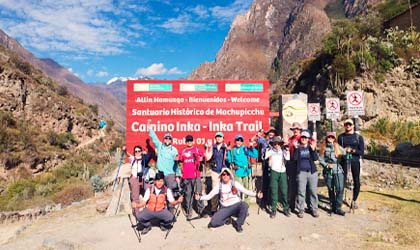
Included Experience
Inca Trail Permit
«Your passport to an adventure of a lifetime.» The memories that await you are priceless.
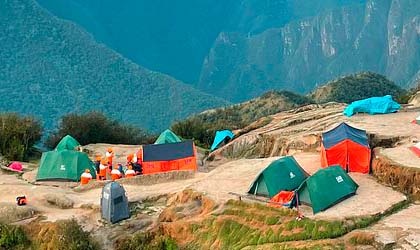
Included Experience
Camping Equipment and Porters Included
Rest assured knowing we have all your camping needs covered. Just bring a toothbrush, a positive attitude and an inquisitive mind.

Included Experience
Llaqtapata
A showcase of the Incas agricultural and astronomical prowess. Be amazed by the rigged stone merging into perfect harmony with delicate nature.
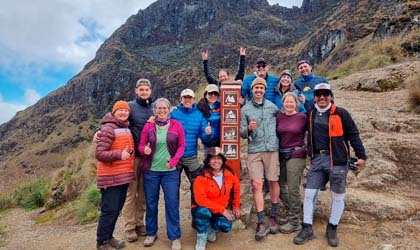
Included Experience
Inca Trail: Discover the Magic of Dead Woman’s Pass
Your mental fortitude will definitely be tested. Once conquered, euphoria and unmatched scenic wonders await you at the top.

Included Experience
Wiñay Wayna
The age-defying site of Wiñay Wayna is unmissable. Surrounded by stunning lush vegetation and the bright orange orchid that it’s named after. A site of intrigue and great mystery.

Included Experience
Historic Sanctuary of Machu Picchu, wonder of the world
It’s the moment you’ve been waiting for! It’s time to explore the wonderful lost citadel of the Incas
Related Tours
«Our meticulously crafted itineraries present endless possibilities. A world of adventures await!»
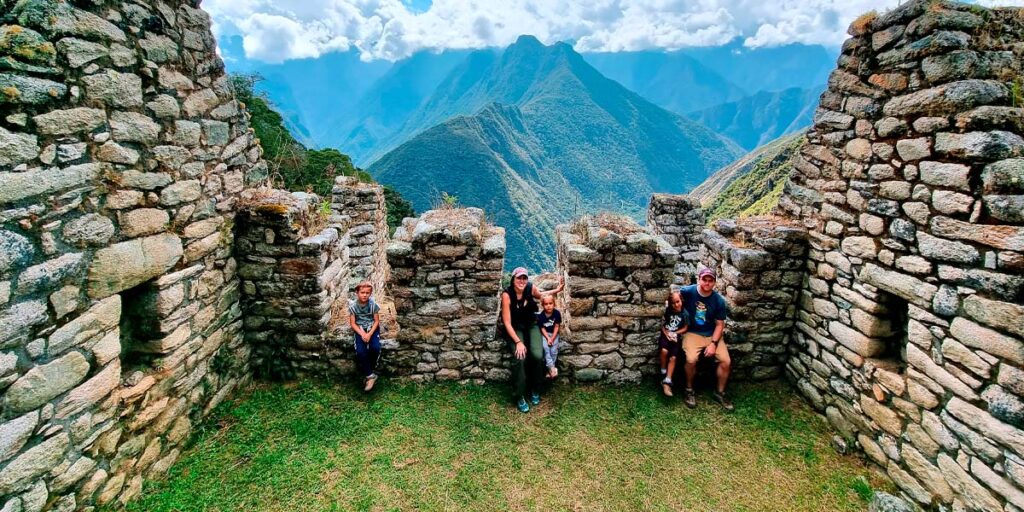
Short Inca Trail; Best Short Hike to Machu Picchu
Trek, adventure2 days - 1 night
Best Short Hike to Machu Picchu; Hike the Short Inca Trail to Machu Picchu in 2 days with an EXPERT Inca Trail Operator in 2024
